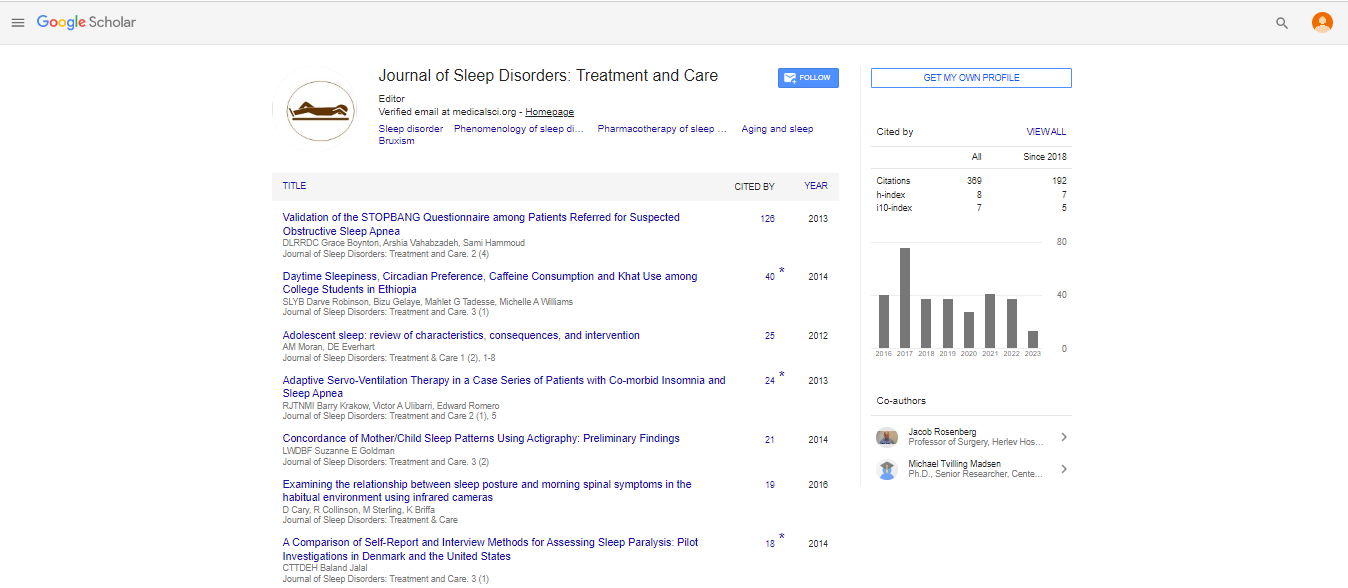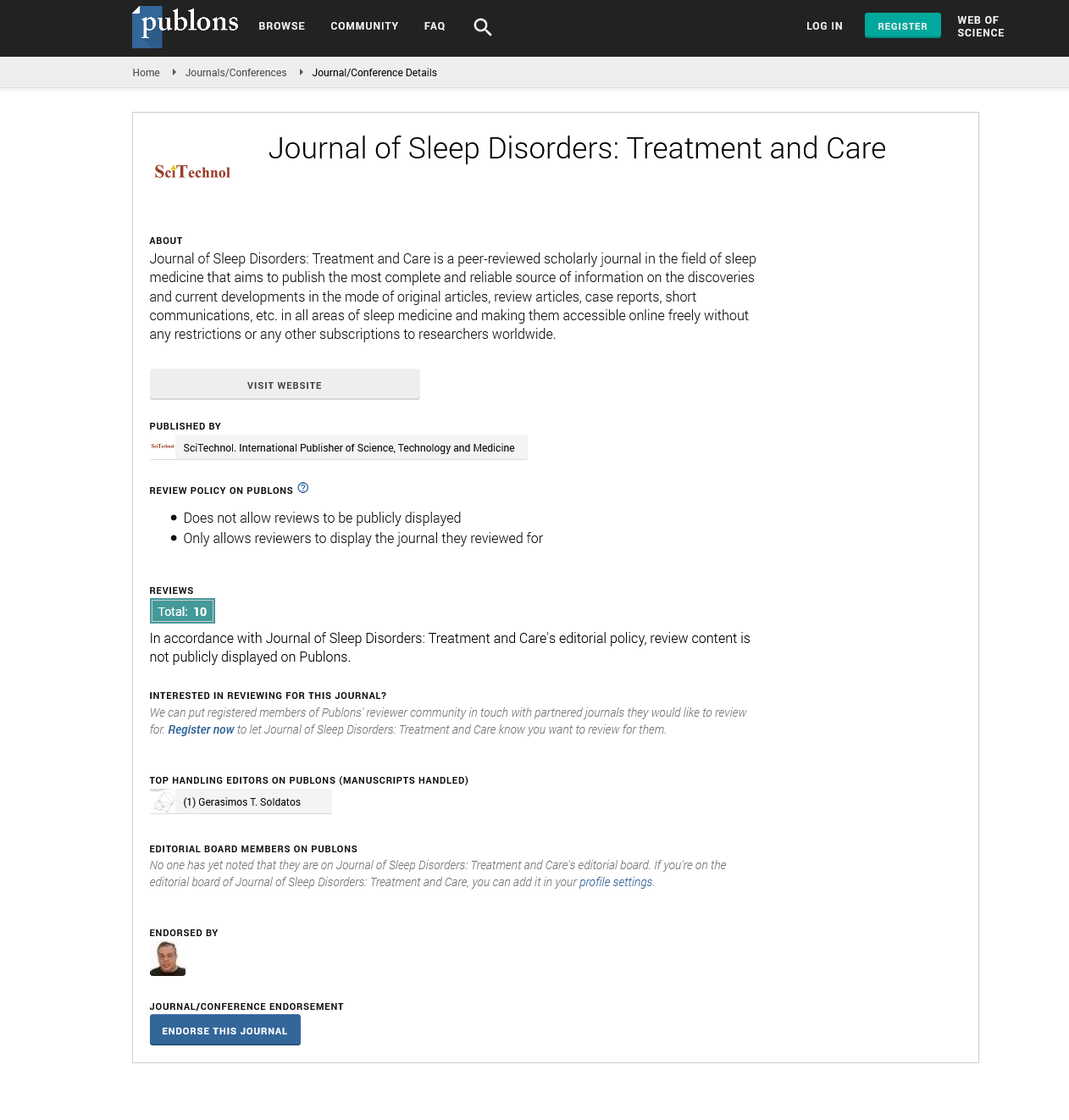Perspective, J Sleep Disor Treat Care Vol: 13 Issue: 1
Night-time Terror: The Enigma of Sleep Paralysis
Ian Jacob*
1Department of Neurology, University of Manitoba, St Boniface General Hospital, Canada, North America
*Corresponding Author: Ian Jacob
Department of Neurology, University of
Manitoba, St Boniface General Hospital, Canada, North America
E-mail: Ianj@yahoo.com
Received date: 19 September, 2024, Manuscript No. JSDTC-24-148329;
Editor assigned date: 23 September, 2024, PreQC No. JSDTC-24-148329 (PQ);
Reviewed date: 07 October, 2024, QC No. JSDTC-24-148329;
Revised date: 14 October, 2024, Manuscript No. JSDTC-24-148329 (R);
Published date: 21 October, 2024, DOI: 10.4172/2325-9639.1000158.
Citation: Jacob I (2024) Night-time Terror: The Enigma of Sleep Paralysis. J Sleep Disor Treat Care 13:1.
Abstract
Description
Sleep paralysis, a condition where an individual temporarily experiences an inability to move or speak while falling asleep or waking up, is often shrouded in mystery and fear. This phenomenon, experienced by many, occurs when a person is in a state between wakefulness and sleep, known as hypnagogic or hypnopompic. Despite its prevalence, sleep paralysis remains a perplexing and unsettling experience for those who encounter it. During an episode of sleep paralysis, individuals may find themselves fully conscious but unable to move their body. This paralysis is accompanied by vivid and often terrifying hallucinations, which can include the sensation of a presence in the room, pressure on the chest, or even the feeling of being suffocated. These experiences can provoke intense fear and panic, as the afflicted person feels trapped in their own body, unable to cry out for help or escape the perceived threat.
The underlying cause of sleep paralysis is linked to disruptions in the sleep cycle. Normally, during Rapid Eye Movement (REM) sleep, the brain sends signals to inhibit motor function to prevent acting out dreams. Sleep paralysis occurs when this REM atonia, or muscle paralysis, persists as a person is transitioning between sleep and wakefulness. This state of incomplete wakefulness can lead to a heightened sense of fear and a distorted perception of reality. Cultural and historical interpretations of sleep paralysis vary widely. In many cultures, these episodes have been attributed to supernatural phenomena. For example, in some traditions, sleep paralysis is linked to malevolent spirits or entities, such as the “Old Hag” in Newfoundland folklore or the “Incubus” in medieval European stories. These cultural explanations often reflect the intense fear and helplessness associated with the condition, illustrating how deeply sleep paralysis can impact one’s perception of reality.
Modern science, however, provides a different perspective. Research into sleep paralysis has revealed that it is a relatively common occurrence, affecting up to 8% of the general population. Factors such as sleep deprivation, irregular sleep schedules and stress are known to increase the likelihood of experiencing sleep paralysis. Furthermore, studies suggest that individuals with narcolepsy, a disorder characterized by excessive daytime sleepiness and sudden sleep attacks, are more prone to sleep paralysis. Treatment and management of sleep paralysis often involve improving sleep hygiene and addressing underlying issues such as stress and anxiety. Regular sleep patterns, a comfortable sleep environment and stress-reducing techniques can help minimize the frequency and severity of episodes. In some cases, cognitive behavioral therapy may be recommended to address the fear and anxiety associated with the condition.
Despite the unsettling nature of sleep paralysis, understanding its physiological and psychological basis can demystify the experience and reduce the fear associated with it. While the sensation of being trapped and the accompanying hallucinations can be distressing, recognizing sleep paralysis as a common and manageable condition can provide relief and encourage those affected to seek appropriate support and treatment. In conclusion, sleep paralysis remains an enigmatic and frightening phenomenon, deeply rooted in both cultural and scientific contexts. By unravelling the mystery behind this condition, individuals can find solace in knowing that they are not alone and that effective strategies exist to lessen its impact.
 Spanish
Spanish  Chinese
Chinese  Russian
Russian  German
German  French
French  Japanese
Japanese  Portuguese
Portuguese  Hindi
Hindi 
